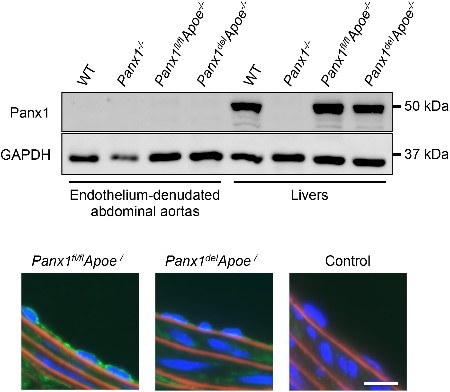Overview
- Peptide (C)KEPTEPKFKGLRLE, corresponding to amino acid residues 18- 31 of human PANX1 (Accession Q96RD7). Intracellular, N-terminus.
- Mouse and rat heart lysates and brain membranes (1:400- 1:1500).
 Western blot analysis of mouse (lanes 1 and 5) and rat (lanes 2 and 6) heart lysates and mouse (lanes 3 and 7) and rat (lanes 4 and 8) brain membranes:1-4. Anti-Pannexin 1 Antibody (#ACC-234), (1:400).
Western blot analysis of mouse (lanes 1 and 5) and rat (lanes 2 and 6) heart lysates and mouse (lanes 3 and 7) and rat (lanes 4 and 8) brain membranes:1-4. Anti-Pannexin 1 Antibody (#ACC-234), (1:400).
5-8. Anti-Pannexin 1 Antibody, preincubated with Pannexin 1 Blocking Peptide (#BLP-CC234).
- Rat free floating brain frozen sections (1:300).
Gap junctions are usually found in clusters and enable intercellular communication by allowing the passage of small molecules between cells1. They play important roles in different biological processes. These include differentiation, cell cycle synchronization, cellular development, neuronal activity and the immune response2-4.
Proteins involved in gap junction formation are composed of four transmembrane domains, two extracellular loops and one intracellular loop and intracellular N- and C-termini5,6. Several consensus cysteine residues are in the extracellular loop and are essential and necessary for intercellular docking of gap junction hemichannels in the opposing cell membrane5-7.
Pannexins (Pannexin 1, Pannexin 2 and Pannexin 3) belong to the superfamily of gap junction proteins. Pannexin 1 (PANX1) is ubiquitously expressed, Pannexin 2 (PANX2) is specifically expressed in the human brain and widespread in rodents and Pannexin 3 (PANX3) is also detected in the brain8.
The gating properties of Pannexins were studied in Xenopus oocytes and results demonstrate that only PANX1 is able to form homomeric hemichannels, and is also able to form heteromeric hemichannels with PANX2 but not with PANX39,10. Not surprising, PANX1 gating properties depend whether it forms homomeric or heteromeric hemichannels.
A number of different stimuli are known to open these channels and include mechanical stress, extracellular ATP, increases in intracellular Ca2+ and inflammation9.
Possible roles for Pannexins include paracrine signaling in vascular endothelial cells and taste cell signaling9. Pannexin-1 was shown to interact with NMDA receptors in epilepsy, ischemia, pain and other pathologies10.
Application key:
Species reactivity key:
 Expression of Pannexin 1 in mouse liver and carotid arteries.A. Western blot analysis of mouse liver lysate using Anti-Pannexin 1 Antibody (#ACC-234). PANX1 is not detected in knockout mice. B. Immunohistochemical staining of mouse carotid artery sections demonstrates PANX1 expression (green) in endothelial cells. No expression is observed in knockout animals (middle panel) nor under conditions where Anti-Pannexin 1 Antibody was omitted (right panel).Adapted from Molica, F. et al. (2017) Sci. Rep. 7, 13706. with permission of Nature Publishing Group.
Expression of Pannexin 1 in mouse liver and carotid arteries.A. Western blot analysis of mouse liver lysate using Anti-Pannexin 1 Antibody (#ACC-234). PANX1 is not detected in knockout mice. B. Immunohistochemical staining of mouse carotid artery sections demonstrates PANX1 expression (green) in endothelial cells. No expression is observed in knockout animals (middle panel) nor under conditions where Anti-Pannexin 1 Antibody was omitted (right panel).Adapted from Molica, F. et al. (2017) Sci. Rep. 7, 13706. with permission of Nature Publishing Group.
